 |
Debug Interrupts: Debugger using single step interrupt, breakpoint interrupt |
| << Real Time Interrupts and Hardware Interfacing |
| Multitasking: Concept, Elaborate, Multitasking Kernel as TSR >> |

10
Debug
Interrupts
10.1.
DEBUGGER USING SINGLE STEP
INTERRUPT
The
use of the trap flag
has been deferred till
now. The three flags
not used
for
mathematical operations are
the direction flag, the
interrupt flag and
the
trap
flag. The direction and
interrupt flags have been
previously discussed.
If the
interrupt flag is set, the
after every instruction a
type 1 interrupt will
be
automatically generated. When
the IVT and reserved
interrupts were
discussed
this was named as the single
step interrupt. This is like
the divide
by zero
interrupt which was never explicitly
invoked but it came itself.
The
single
step interrupt behaves in
the same manner.
The
debugger is made using this
interrupt. It allows one
instruction to be
executed
and then return control to
us. It has its display
code and its code
to
wait
for the key in the INT 1
handler. Therefore after
every instruction the
values
of all registers are shown
and the debugger waits
for a key. Another
interrupt
used by the debugger is the
break point interrupt INT 3.
Apart from
single
stepping debugger has the
breakpoint feature. INT 3 is used
for this
feature.
INT 3 has a single byte
opcode so it can replace any
instruction. To
put a
breakpoint the instruction is
replaced with INT 3 opcode and
restored
in the
INT 3 handler. The INT 3 opcode is
placed again by a single
step
interrupt
that is set up for this
purpose after the replaced
instruction has
been
executed.
There
is no instruction to set or clear
the trap flag like
there are
instructions
for the interrupt and
direction flags. We use two
special
instructions
PUSHF and POPF to push
and pop the flag
from the stack. We
use
PUSHF to place flags on the
stack, change TF in this
image on the stack
and
then reload into the
flags register with POPF.
The single step
interrupt
will
come after the first
instruction after POPF. The
interrupt mechanism
automatically
clears IF and TF otherwise
there would an infinite
recursion of
the
single step interrupt. The
TF is set in the flags on
the stack so another
interrupt
will comes after one more
instruction is executed after
the return of
the
interrupt.
The
following example is a very
elementary debugger using
the trap flag
and
the single step
interrupt.
Example
10.1
001
; single stepping using the
trap flag and single step interrupt
002
[org
0x0100]
003
jmp start
004
005
flag:
db
0
; flag whether a
key pressed
006
oldisr:
dd
0
; space for saving
old ISR
007
names:
db
'FL =CS =IP
=BP =AX =BX =CX
=DX =SI =DI =DS =ES
='
008
009-026
;;;;; COPY LINES
008-025 FROM EXAMPLE 6.2 (clrscr)
;;;;;
027
028
; subroutine to print a
number on screen
029
; takes the row
no, column no, and number to be printed
as parameters
030
printnum:
push
bp
031
mov bp,
sp
032
push
es
033
push
ax
034
push
bx
035
push
cx
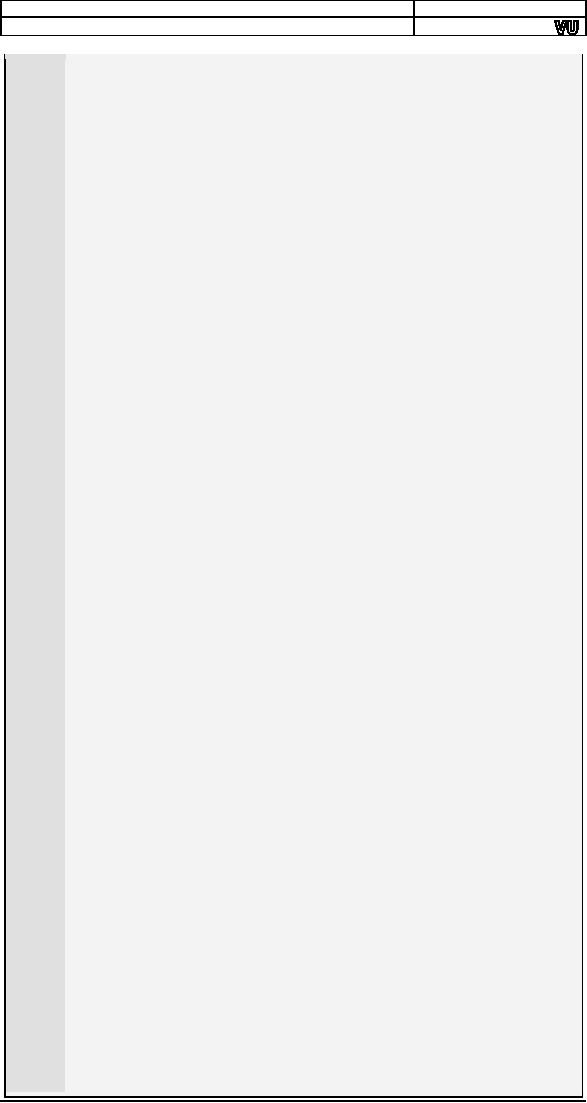
Computer
Architecture & Assembly Language
Programming
Course
Code: CS401
CS401@vu.edu.pk
036
push
dx
037
push
di
038
039
mov
di,
80
;
load di with
columns per row
040
mov
ax,
[bp+8]
;
load ax with row
number
041
mul
di
;
multiply with
columns per row
042
mov
di,
ax
;
save result in
di
043
add
di,
[bp+6]
;
add
column number
044
shl
di,
1
;
turn into byte
count
045
add
di,
8
;
to end of
number location
046
047
mov
ax,
0xb800
048
mov
es,
ax
;
point es to video
base
049
mov
ax,
[bp+4]
;
load number in
ax
050
mov
bx,
16
;
use
base 16 for division
051
mov
cx,
0
;
initialize count of
digits
052
053
nextdigit:
mov dx,
0
;
zero upper half of
dividend
054
div
bx
;
divide by
10
055
add dl,
0x30
;
convert digit into ascii
value
056
cmp dl,
0x39
;
is the digit an
alphabet
057
jbe
skipalpha
;
no, skip
addition
058
add dl,
7
;
yes, make in
alphabet code
059
skipalpha:
mov dh,
0x07
;
attach normal
attribute
060
mov [es:di],
dx
;
print char on
screen
061
sub di,
2
;
to previous screen
location
062
loop
nextdigit
;
if no divide it
again
063
064
pop
di
065
pop
dx
066
pop
cx
067
pop
bx
068
pop
ax
069
pop
es
070
pop
bp
071
ret
6
072
073
; subroutine to print a
string
074
; takes row no,
column no, address of string, and its
length
075
; as
parameters
076
printstr:
push
bp
077
mov bp,
sp
078
push
es
079
push
ax
080
push
bx
081
push
cx
082
push
dx
083
push
si
084
push
di
085
086
mov
ax,
0xb800
087
mov
es, ax
; point es to video
base
088
089
mov
di,
80
;
load di with
columns per row
090
mov
ax,
[bp+8]
;
load ax with row
number
091
mul
di
;
multiply with
columns per row
092
mov
di,
ax
;
save result in
di
093
add
di,
[bp+6]
;
add
column number
094
shl
di,
1
;
turn into byte
count
095
096
mov
si, [bp+6]
; string to be
printed
097
mov
cx, [bp+4]
; length of
string
098
mov
ah,
0x07
; normal attribute is
fixed
099
100
nextchar:
mov
al, [si]
;
load next char of
string
101
mov
[es:di], ax
;
show next char on
screen
102
add
di, 2
;
move to next
screen location
103
add
si, 1
;
move to next
char
104
loop
nextchar
;
repeat the operation cx
times
105
106
pop
di
107
pop
si
108
pop
dx
109
pop
cx
110
pop
bx
111
pop
ax
126
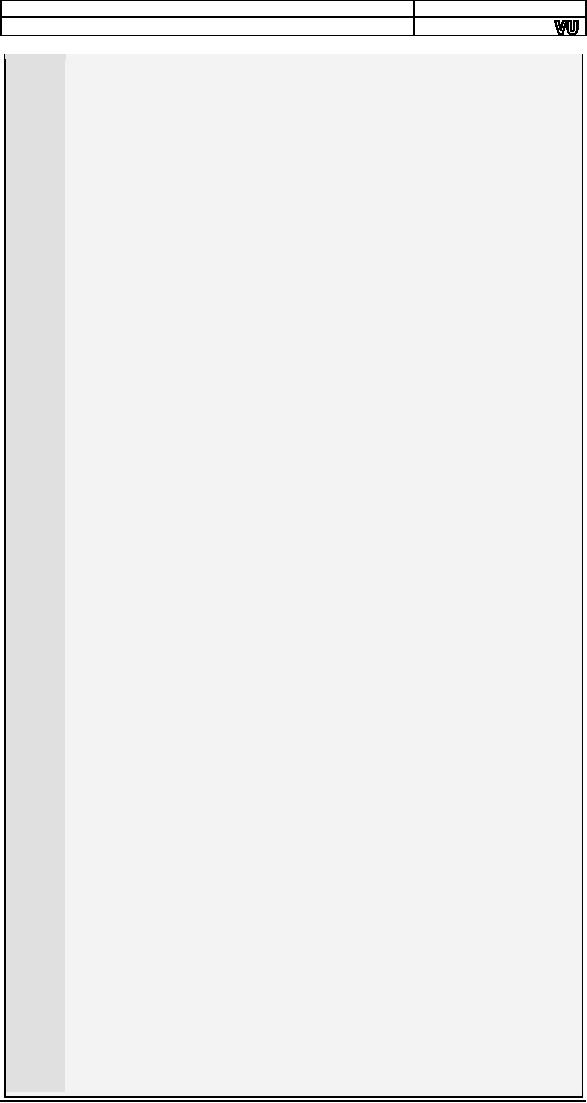
Computer
Architecture & Assembly Language
Programming
Course
Code: CS401
CS401@vu.edu.pk
112
pop
es
113
pop
bp
114
ret
8
115
116
; keyboard
interrupt service routine
117
kbisr:
push
ax
118
119
in
al,
0x60
;
read a char from
keyboard port
120
test
al,
0x80
;
is it a press
code
121
jnz
skipflag
;
no, leave the
interrupt
123
add
byte [cs:flag],
al
;
yes, set flag to
proceed
124
125
skipflag:
mov al,
0x20
126
out 0x20,
al
127
pop
ax
128
iret
129
130
; single step interrupt service
routine
131
trapisr:
push
bp
132
mov bp,
sp
; to read cs, ip
and flags
133
push
ax
134
push
bx
135
push
cx
136
push
dx
137
push
si
138
push
di
139
push
ds
140
push
es
141
142
sti
; waiting for
keyboard interrupt
143
push
cs
144
pop
ds
; initialize ds to data
segment
145
146
mov byte
[flag], 0
; set flag to wait for
key
147
call clrscr
; clear the
screen
148
149
mov
si,
6
;
first
register is at
bp+6
150
mov
cx,
12
;
total
12 registers to
print
151
mov
ax,
0
;
start
from row
0
152
mov
bx,
5
;
print
at column
5
153
154
l3:
push
ax
; row
number
155
push
bx
; column
number
156
mov
dx, [bp+si]
157
push
dx
;
number to be
printed
158
call
printnum
;
print the
number
159
sub
si, 2
;
point to next
register
160
inc
ax
;
next row
number
161
loop
l3
;
repeat for the 12
registers
162
163
mov
ax,
0
;
start from row
0
164
mov
bx,
0
;
start from column
0
165
mov
cx,
12
;
total 12 register
names
166
mov
si,
4
;
each
name length is 4 chars
167
mov
dx,
names
;
offset of first
name in dx
168
169
l1:
push
ax
;
row
number
170
push
bx
;
column
number
171
push
dx
;
offset of
string
172
push
si
;
length of
string
173
call
printstr
;
print the
string
174
add
dx, 4
;
point to start of next
string
175
inc
ax
;
new
row number
176
loop
l1
;
repeat for 12 register
names
177
178
keywait:
cmp
byte [flag],
0
; has a key
been pressed
179
je
keywait
; no, check
again
180
181
pop
es
182
pop
ds
183
pop
di
184
pop
si
185
pop
dx
186
pop
cx
187
pop
bx
188
pop
ax
127
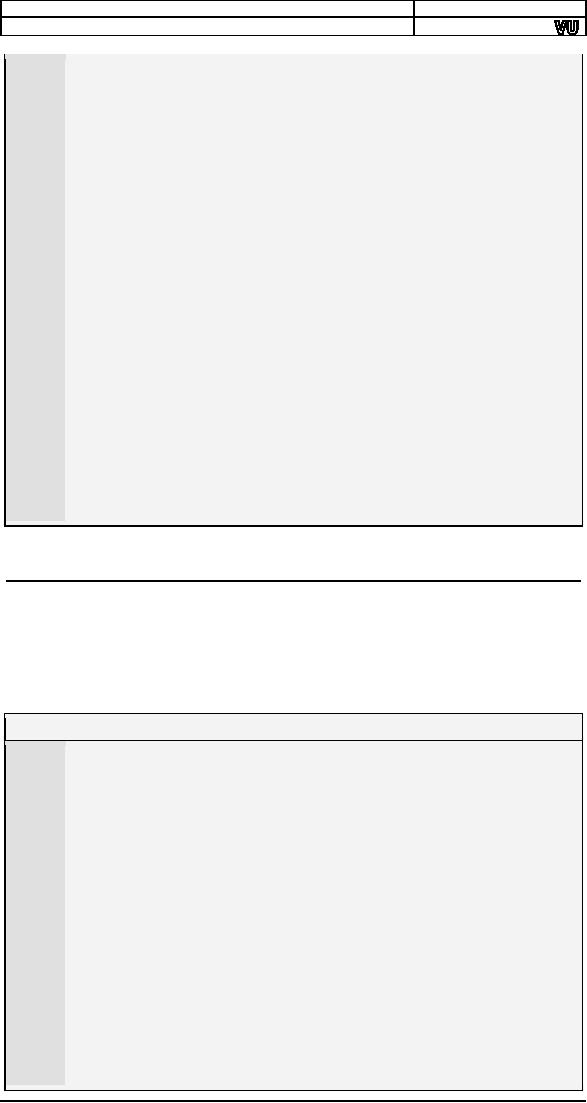
Computer
Architecture & Assembly Language
Programming
Course
Code: CS401
CS401@vu.edu.pk
189
pop
bp
190
iret
191
192
start:
xor
ax, ax
193
mov
es, ax
; point es to IVT
base
194
mov
ax,
[es:9*4]
195
mov
[oldisr],
ax
; save offset of
old routine
196
mov
ax,
[es:9*4+2]
197
mov
[oldisr+2],
ax
; save
segment of old routine
198
mov
word [es:1*4],
trapisr ; store offset at n*4
199
mov
[es:1*4+2],
cs
; store segment at
n*4+2
200
cli
; disable
interrupts
201
mov
word [es:9*4],
kbisr ; store offset at n*4
202
mov
[es:9*4+2],
cs
; store segment at
n*4+2
203
sti
; enable
interrupts
204
205
pushf
;
save flags on
stack
206
pop
ax
;
copy flags in
ax
207
or
ax,
0x100
;
set bit
corresponding to TF
208
push
ax
;
save ax on
stack
209
popf
;
reload into flags
register
210
211
; the trap flag bit
is
on now, INT 1 will
come after next instruction
212
; sample
code to check
the working of our
elementary debugger
213
mov
ax,
0
214
mov
bx,
0x10
215
mov
cx,
0x20
216
mov
dx,
0x40
217
218
l2:
inc
ax
219
add
bx, 2
220
dec
cx
221
sub
dx, 2
222
jmp
l2
10.2.
DEBUGGER USING BREAKPOINT
INTERRUPT
We now
write a debugger using INT 3.
This debugger stops at the
same
point
every time where the
breakpoint has been set up
unlike the previous
one
which stopped at every instruction.
The single step interrupt in
this
example
is used only to restore the
breakpoint interrupt which was
removed
by the
breakpoint interrupt handler
temporarily so that the
original
instruction
can be executed.
Example
10.2
001
; elementary
debugger using breakpoint interrupt
002
[org
0x0100]
003
jmp start
004
005
flag:
db
0
; flag whether a
key pressed
006
oldisr:
dd
0
; space for saving
old ISR
007
names:
db
'FL =CS =IP
=BP =AX =BX =CX
=DX =SI =DI =DS =ES
='
008
opcode:
db 0
009
opcodepos:
dw 0
010
011-028
;;;;;
COPY
LINES
008-025
FROM
EXAMPLE
6.2 (clrscr)
;;;;;
029-072
;;;;;
COPY
LINES
028-071
FROM
EXAMPLE
10.1 (printnum)
;;;;;
073-114
;;;;;
COPY
LINES
073-114
FROM
EXAMPLE
10.1 (printstr)
;;;;;
115-127
;;;;;
COPY
LINES
116-128
FROM
EXAMPLE
10.1 (kbisr)
;;;;;
128
129
; single step interrupt service
routine
130
trapisr:
push
bp
131
mov bp,
sp
132
push
ax
133
push
di
134
push
ds
135
push
es
136
137
push
cs
138
pop
ds
; initialize ds to data
segment
128
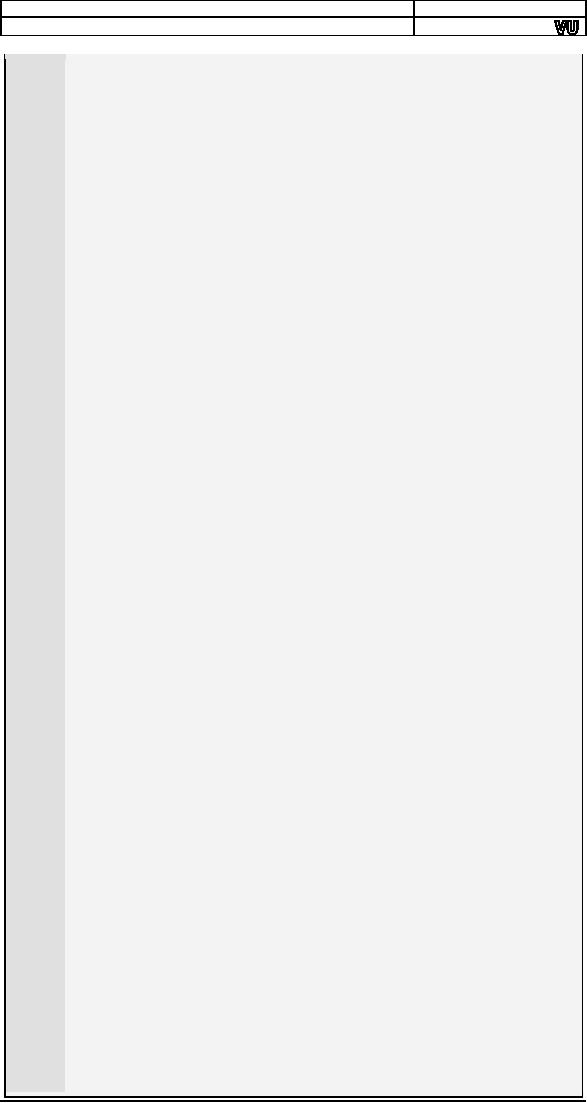
Computer
Architecture & Assembly Language
Programming
Course
Code: CS401
CS401@vu.edu.pk
139
140
mov
ax, [bp+4]
141
mov
es, ax
;
load interrupted
segment in es
142
mov
di,
[opcodepos]
;
load saved
opcode position
143
mov
byte [es:di], 0xCC
;
reset the opcode
to INT3
144
and
word [bp+6],
0xFEFF;
clear TF in flags on
stack
145
146
pop
es
147
pop
ds
148
pop
di
149
pop
ax
150
pop
bp
151
iret
152
153
; breakpoint interrupt service
routine
154
debugisr:
push
bp
155
mov bp,
sp
; to read cs, ip
and flags
156
push
ax
157
push
bx
158
push
cx
159
push
dx
160
push
si
161
push
di
162
push
ds
163
push
es
164
165
sti
; waiting for
keyboard interrupt
166
push
cs
167
pop
ds
; initialize ds to data
segment
168
169
mov
ax, [bp+4]
170
mov
es, ax
; load interrupted
segment in es
171
dec
word
[bp+2]
; decrement the
return address
172
mov
di, [bp+2]
; read the return
address in di
173
mov
word [opcodepos],
di ; remember the return position
174
mov
al,
[opcode]
; load the original
opcode
175
mov
[es:di], al
; restore original
opcode there
176
177
mov byte
[flag], 0
; set flag to wait for
key
178
call clrscr
; clear the
screen
179
180
mov
si,
6
;
first
register is at
bp+6
181
mov
cx,
12
;
total
12 registers to
print
182
mov
ax,
0
;
start
from row
0
183
mov
bx,
5
;
print
at column
5
184
185
l3:
push
ax
; row
number
186
push
bx
; column
number
187
mov
dx, [bp+si]
188
push
dx
;
number to be
printed
189
call
printnum
;
print the
number
190
sub
si, 2
;
point to next
register
191
inc
ax
;
next row
number
192
loop
l3
;
repeat for the 12
registers
193
194
mov
ax,
0
;
start from row
0
195
mov
bx,
0
;
start from column
0
196
mov
cx,
12
;
total 12 register
names
197
mov
si,
4
;
each
name length is 4 chars
198
mov
dx,
names
;
offset of first
name in dx
199
200
l1:
push
ax
;
row
number
201
push
bx
;
column
number
202
push
dx
;
offset of
string
203
push
si
;
length of
string
204
call
printstr
;
print the
string
205
add
dx, 4
;
point to start of next
string
206
inc
ax
;
new
row number
207
loop
l1
;
repeat for 12 register
names
208
209
or word [bp+6],
0x0100
; set TF in flags
image on stack
210
211
keywait:
cmp
byte [flag],
0
; has a key
been pressed
212
je
keywait
; no, check
again
213
214
pop
es
129
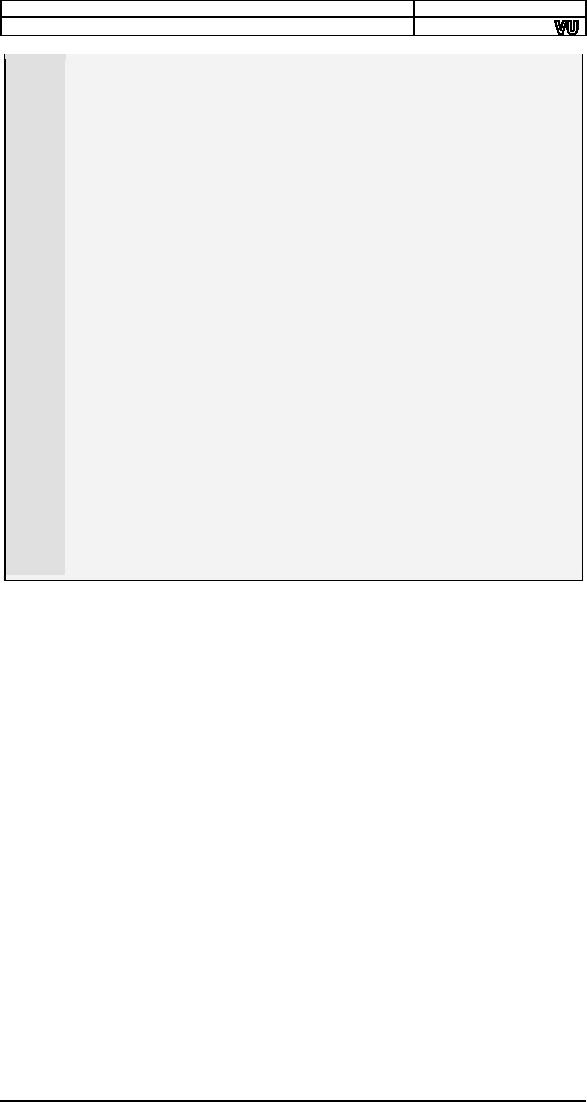
Computer
Architecture & Assembly Language
Programming
Course
Code: CS401
CS401@vu.edu.pk
215
pop
ds
216
pop
di
217
pop
si
218
pop
dx
219
pop
cx
220
pop
bx
221
pop
ax
222
pop
bp
223
iret
224
225
start:
xor
ax, ax
226
mov
es, ax
; point es to IVT
base
227
mov
word [es:1*4],
trapisr ; store offset at n*4
228
mov
[es:1*4+2],
cs
; store segment at
n*4+2
229
mov
word [es:3*4],
debugisr ; store offset at n*4
230
mov
[es:3*4+2],
cs
; store segment at
n*4+2
231
cli
; disable
interrupts
232
mov
word [es:9*4],
kbisr ; store offset at n*4
233
mov
[es:9*4+2],
cs
; store segment at
n*4+2
234
sti
; enable
interrupts
235
236
mov
si, l2
;
load breakpoint position in
si
237
mov
al, [cs:si]
;
read opcode at
that position
238
mov
[opcode],
al
;
save
opcode for later use
239
mov
byte [cs:si],
0xCC
;
change
opcode to INT3
240
241
; breakpoint is set
now, INT3 will come at l2 on every
iteration
242
; sample
code to check the working of our
elementary debugger
243
mov ax,
0
244
mov bx,
0x10
245
mov cx,
0x20
246
mov dx,
0x40
247
248
l2:
inc
ax
249
add
bx, 2
250
dec
cx
251
sub
dx, 2
252
jmp
l2
130
Table of Contents:
- Introduction to Assembly Language Programming
- Addressing Modes: Data Declaration, Direct, Register Indirect , Offset Addressing
- Branching: Comparison and Conditions, Conditional ,Unconditional Jump
- Manipulations: Multiplication Algorithm, Shifting and Rotations, Bitwise Logical Operations
- Subroutines: Program Flow, Stack, Saving and Restoring Registers
- Display Memory: ASCII Codes, Display Memory Formation, Assembly Language
- String Instructions: String Processing, Clearing Screen, String Printing, Length
- Software Interrupts: Hooking an Interrupt, BIOS and DOS Interrupts
- Real Time Interrupts and Hardware Interfacing
- Debug Interrupts: Debugger using single step interrupt, breakpoint interrupt
- Multitasking: Concept, Elaborate, Multitasking Kernel as TSR
- Video Services: BIOS Video Services, DOS Video Services
- Secondary Storage: Storage Access Using BIOS, DOS, Device Drivers
- Serial Port Programming: Serial Communication
- Protected Mode Programming: VESA Linear Frame Buffer, Interrupt Handling
- Interfacing with High Level Languages: Calling Conventions, Calling C from Assembly
- Comparison: Motorolla 68K Processors, Sun SPARC Processor